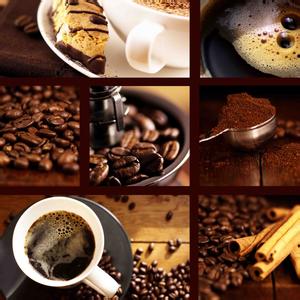How many ways do you make coffee? The way to make coffee
The quality of ground coffee has a significant impact on the subsequent cooking process. Matching the grinding process with the cooking method is also crucial to extracting the best flavor from the beans. Cooking methods that allow coffee grounds to be in contact with hot water for a long time require coarser particles. If the grounds are too fine for the brewing method, the coffee will have a bitter, hard,"overcooked" taste. At the other extreme, of course, coffee grounds that are too coarse can make the finished product bland.
Because of the large contact area between the powder and the air, the ground coffee powder is easy to oxidize and degrade. As people's taste in coffee improves, more and more people tend to grind coffee beans at home and brew them freshly. There are many household appliances dedicated to coffee grinding.
Coffee beans are ground in three ways: grinding, grinding and mortar grinding.

"Grinding" is squeezing and crushing coffee beans with two rotating parts. The abrasive member may be disc or conical. Cone machines are less noisy and less likely to jam. The ground method produces coffee grounds that are more uniform and have a more consistent flavor when cooked. The conical disc design reduces the required rotational speed, typically below 500 rpm. The slower the grinding speed, the less heat generated by friction, so the aroma of coffee is not lost easily. By adjusting the grinding parameters, the cone grinder can be used for a variety of coffee preparations. A better machine can grind the fine powder needed for Turkish coffee. Disc grinders generally rotate at a higher speed and generate more heat; however, they are versatile, economical and practical, and can be used for most household coffee preparations.
"Grind": Most modern machines actually grind coffee beans at high speeds of 20,000 to 30,000 rpm (some people simply use a beater). These blade grinders have a longer life expectancy; however, heat builds up during grinding and the size of the coffee powder is uneven, making it difficult to produce quality drinks. This type of sander can theoretically only be used for drip coffee pots. They produce dust that can clog filters in Espresso and French press machines.
"Mortar mill": If you can't find good grinding equipment, all you can do is use a pestle and a mortar, and enjoy the fun of labor slowly.
Cooking Coffee brewing is classified into four categories according to the way water and coffee grounds come into contact: "brewing","pressure","gravity" and "leaching".
If the water passes through the coffee grounds only once, the finished product will mainly contain soluble substances (including caffeine). If the water circulates through the coffee grounds multiple times (as in a common circulating filter), less soluble substances in the coffee beans will also enter the finished product, resulting in a bitter taste; this method is therefore not favored by enthusiasts.
All coffee is made from ground coffee and hot water; the ground coffee is cleaned out afterwards. The degree of fineness required depends on the cooking method chosen.
Proper water temperature is crucial. The recommended temperature is 93 degrees Celsius. The water temperature is too low, the flavor in the coffee beans cannot be fully extracted; the water temperature is too high, the extraction is excessive, the taste deteriorates and often bitter.
A common ratio of coffee grounds to water in Western countries is 15 to 30 ml of coffee grounds (one to two tablespoons): 300 ml of water (six ounces). Coffee lovers often take the upper limit of this ratio. Please note that appropriate adjustments are made according to the thickness of the coffee grounds.
Continued heating destroys the flavor of brewed coffee, and degradation also occurs at room temperature. So keeping brewed coffee warm is often a failure. However, in an oxygen-free environment, coffee can be stored at room temperature for a long time. So you can see coffee in sealed packages on store shelves.
Many electric coffee pots are now highly automated, and some even include the function of grinding coffee beans.
Don't be misled by the name. Don't boil coffee (at least not too long) or it will be too bitter.
The easiest way is to put the coffee grounds in a cup, add hot water, and let it cool while the coffee grounds sink. This is an old method that is still used in some parts of Indonesia. Be careful not to eat coffee at the bottom of the cup. The advantage of this method is that it is simple and the water temperature is just right.
Turkish coffee is an early recipe and is still used in the Middle East, North Africa, East Africa, Turkey, Greece and the Balkans. Superfine coffee ground is boiled in water in a small container, usually flavored with sugar and cardamom. Espresso coffee in a cup has foam on top and a layer of powder under it.
Cowboy coffee is brewed directly in a pot with ground coffee and water. The name suggests a stopgap in crude conditions; however, some prefer it. In Finland and Sweden, where coffee consumption per capita is highest, this is the traditional cooking method.
Pressurized espresso coffee is made from hot water at 91~96 degrees Celsius at 8~9 atmospheres through compacted coffee powder, which is only 30 ml per cup. It is one of the strongest coffees in common, with a distinctive aroma and a touch of Crema floating on the surface. It can be drunk alone (for dessert after dinner); it can also be further made into a variety of other drinks. Due to the rapid brewing, high concentration characteristics, and low caffeine content, in many chain coffee shops or flavored coffee are used in this way.
Mocha pot, also known as "Italian coffee pot", is a three-layer structure of the stove. Boiling water in the bottom layer after vapor pressure pushed through the middle of the coffee grounds into the upper layer, the resulting coffee concentration is comparable to espresso, but no oil slick.
The gravity method American coffee or filter paper method is made by placing coffee grounds on a filter paper or metal filter and flowing hot water from top to bottom. The strength of coffee depends on the proportion of water added and the thickness of coffee grounds, but it is generally lower than espresso.
Electric circulating filters were very popular in the United States before the 1970s. It is different from the mocha pot mentioned above: hot water boils into the top layer, then flows down through the coffee grounds and back into the heating chamber; and so on several times. It is precisely because the hot water passes through the coffee grounds many times in this method that this coffee tastes bad.
The French press is a tall thin glass cylinder with a piston with a filter. The hot water and coffee grounds soak in the cylinder for four to seven minutes, then the piston filter presses the coffee grounds to the bottom, and the upper coffee can be poured out for drinking. This "full immersion method" is considered by many experts to be the ideal home method for brewing coffee.
Coffee bags are portable packaging for travel, which is rare at ordinary times. Malaysians use muslim bags to hold coffee grounds and immerse them in hot water. This kind of pocket is the same as using filter paper. This is especially true for strong Malay local coffees-the coffee in the bag can be reused.
Vacuum coffee pot is made up of a heating container and a funnel-type container connected. The connecting part is a filter on which coffee grounds are placed. The water boils in the heating vessel and enters the funnel to mix with the coffee grounds; the heating source is turned off, and the partial vacuum created by cooling the heating vessel draws the coffee back through the filter to the bottom of the funnel.
Important Notice :
前街咖啡 FrontStreet Coffee has moved to new addredd:
FrontStreet Coffee Address: 315,Donghua East Road,GuangZhou
Tel:020 38364473
- Prev

Where does the smell that often appears in coffee come from?
2-ethyl-3-℃-5-dimethylpyrazine-furanone (Sotolon) is sweet, caramel, maple, brown sugar 184 degrees ℃ 4-ethyl guaiacol 4-Ethylguaiacol is sweet and warm.
- Next

Coffee brewing utensils and using utensils and methods for brewing coffee
First, filter paper brewing-the easiest brewing method [characteristics] the simplest coffee brewing method. Filter paper can be discarded immediately after use, which is more sanitary and easy to clean up. The amount of boiling water and the injection method can also be adjusted. One person can also brew, which is the best way to brew a small number of people. [about apparatus] the drip can be divided into one hole and three holes. Three holes are used here. Inject boiled water
Related
- Detailed explanation of Jadeite planting Land in Panamanian Jadeite Manor introduction to the grading system of Jadeite competitive bidding, Red bid, Green bid and Rose Summer
- Story of Coffee planting in Brenka region of Costa Rica Stonehenge Manor anaerobic heavy honey treatment of flavor mouth
- What's on the barrel of Blue Mountain Coffee beans?
- Can American coffee also pull flowers? How to use hot American style to pull out a good-looking pattern?
- Can you make a cold extract with coffee beans? What is the right proportion for cold-extracted coffee formula?
- Indonesian PWN Gold Mandrine Coffee Origin Features Flavor How to Chong? Mandolin coffee is American.
- A brief introduction to the flavor characteristics of Brazilian yellow bourbon coffee beans
- What is the effect of different water quality on the flavor of cold-extracted coffee? What kind of water is best for brewing coffee?
- Why do you think of Rose Summer whenever you mention Panamanian coffee?
- Introduction to the characteristics of authentic blue mountain coffee bean producing areas? What is the CIB Coffee Authority in Jamaica?

